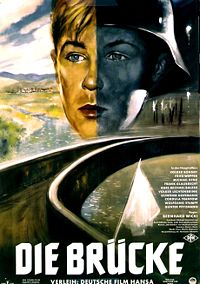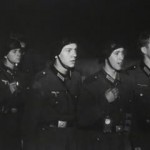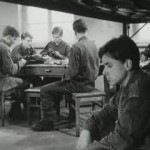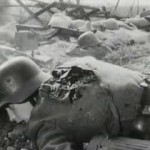 They look for love in a world of violence!
They look for love in a world of violence!
The Bridge is an outstanding film but one that is rarely mentioned today. It is unique in many ways. For starters, it’s a foreign language film, filmed and shot entirely in German by director Bernhard Wicki. It is available with subtitles however: and do not let those deter you. The Bridge as emotionally powerful film as you will ever see- and an early film showing the war from the German point of view.
 The story (which recounts true events) takes place in the closing days of the Second World War and revolves around seven boy- young teenagers. Although none of the seven is memorable –probably by design –we see these boys doing what boys due, arguing with parents, exploring riverbanks, and dreaming of being a hero.
The story (which recounts true events) takes place in the closing days of the Second World War and revolves around seven boy- young teenagers. Although none of the seven is memorable –probably by design –we see these boys doing what boys due, arguing with parents, exploring riverbanks, and dreaming of being a hero.
All this is set in the despair and destruction of a German town obviously hit with numerous air raids. Rubble lines the streets and ration cards are guarded carefully. For the first half of the picture we get a picture of how the average German family dealt with life towards the end and tried to maintain a sense of normalcy. “Real soap” for example is a big deal. We see mothers worried about their husbands, children going to school, etc.
Lots of the teens play centers around a bridge which crosses the middle of town.
 We also learn through their daydreams of the total indoctrination of these seven youths with the evils of Hitler and Nazism. To the film’s credit (and again this was probably by design) there is no true inclusion of Hitler, no actor trying to play him and no newsreel footage either. This film is purely at the local level.
We also learn through their daydreams of the total indoctrination of these seven youths with the evils of Hitler and Nazism. To the film’s credit (and again this was probably by design) there is no true inclusion of Hitler, no actor trying to play him and no newsreel footage either. This film is purely at the local level.
We hear these children talk about winning the war and dreaming of when their enlistment papers come (and it’s indicative of German organization that at this late date the MAIL was still functioning). They talk of stopping the advancing Americans.
 When the papers do come and they do enlist we feel their excitement. Chatter of becoming officers and not needing socks to take along (“But I’ll be wearing army socks then, mother.”) and how to properly use a bayonet (“It has to be dull or it will come right back out. You want it dull so you have to push against him with your boot.”) As they go through their training we continue to see their ignorance of the true state of affairs and complete brainwashing by the Nazi leadership.
When the papers do come and they do enlist we feel their excitement. Chatter of becoming officers and not needing socks to take along (“But I’ll be wearing army socks then, mother.”) and how to properly use a bayonet (“It has to be dull or it will come right back out. You want it dull so you have to push against him with your boot.”) As they go through their training we continue to see their ignorance of the true state of affairs and complete brainwashing by the Nazi leadership.
As expected, the teens receive very little training before they are sent into combat. Their commanders, realizing that the war is lost, post them to guard their bridge- presuming that it will remain relatively safely behind the front lines.
However the German lines are quickly overrun and the bridge becomes the front line. Fanatically, the teens refuse to abandon the bridge even in light of the urging of soldiers retreating from the front.
 The Americans arrive with a few tanks and a firefight ensues. The teens grimly smile with satisfaction when they kill an American soldier at a distance, but up close they are horrified. As the battle continues, the children are killed, but for the most part not before realizing the true horror of what they have gotten into.
The Americans arrive with a few tanks and a firefight ensues. The teens grimly smile with satisfaction when they kill an American soldier at a distance, but up close they are horrified. As the battle continues, the children are killed, but for the most part not before realizing the true horror of what they have gotten into.
Two survive the initial assault and are retreating across the bridge as a German demolition squad arrives. The teens refuse to let them blow the bridge and end up shooting one of the squad members in a fanatic rage. But one of the remaining teens also perishes.
As the curtain falls we see the final teen wandering off the bridge in a haze. The entire film is an extended saga of the total waste of German youth at the end of the war and the impacts of mad fanatizism on young impressionable minds.
Technically the film isn’t breathtaking – although technically a war film only the last third is action- which is very well done. The remainder is really simple street seens. The black and white photography lends a greater air of authenticity over what could have been a color film.
Get it. See it.
I saw this in Heidelberg, Gémany while I the US Army in 1959.